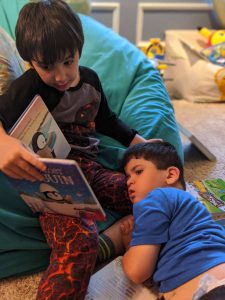Ever since Joey started kindergarten I’ve struggled with the idea of how to assess his reading ability. Although I can encourage him to use his device to match the words on the page, thi s is laborious and time consuming for him. It certainly does not promote reading fluency or the phonemic process needed to decode unfamiliar words. But, if Joey isn’t read aloud, how do we know he’s reading?
s is laborious and time consuming for him. It certainly does not promote reading fluency or the phonemic process needed to decode unfamiliar words. But, if Joey isn’t read aloud, how do we know he’s reading?
When we read leveled books I try to take turns reading words with Joey. As we read I’ll point under each word and talk about how my voice or the word on the device matches the word on the page. I’ll pause at words Joey can quickly read on his device, or at words that I want Joey to learn to read on his device so that he has an opportunity to read the word as we go. I have each word from the sentence laminated on a piece of paper with velcro so that Joey can build the sentence himself when given the words. This requires him to attend to the different letters in each word and put them in sequential order – holding each word in his head as we place it in a meaningful spot in a sentence.
But all of that still doesn’t let me know whether or not Joey is attending to the story – or if what I am asking him to do is so beneath him that he is bored.
After a quick assessment (and then another, and another), I realized that Joey learned more high frequency words (or sight words – and, in, here, the) during our quarantine time. He is clearly taking in what he reads and remembering what these words are. So what else does he know?
Finally, I printed out two copies of one of the personalized level readers from Pioneer Valley. One copy I put together into a book so that Joey could read it. The other one I cut out the words and the pictures for them, laminated and added velcro to the back of each word. Now, I have an ability to make a sentence without a picture attached and ask Joey to match the pictures to the words (when given a field of 6 pictures). OR, I can show Joey a picture and ask him to find the word that matches.
Joey, of course, surprised me with how well he did the first time I presented the activity. He clearly attended to each word in the sentence and then correctly matched the picture. The second time we did the activity he was less engaged. By now the simple level B book was boring for him and the task was old news. He scanned the sentences but would only match part of the picture correctly. Although he was not nearly as accurate as he was the first time, this gave me great insight into Joey as a reader. When it is novel and interesting Joey will attend to all of the details in the book. When he thinks he already knows what is on the page (like all six year olds I am currently working with on learning to read) he will scan the page and make assumptions about what the words say. As frustrating as it is, this is something we have to teach all new readers – continue to engage with the words on the page – and read what is actually there, not what you think should be there.
I am excited to try this with another book – and to increase the level to see if Joey is capable of reading at grade level. By the end of kindergarten and the beginning of first grade, students should be reading a level 4/D book if they are being assessed using the Developmental Reading Assessment, Fountas and Pinnell, or Pioneer Valley assessments. Joey is below in this area but only because of his limitations to performing the task. He may be able to do more than we think he can, he is just unable to orally read the words on the page like we expect.
Stay tuned to find out!


